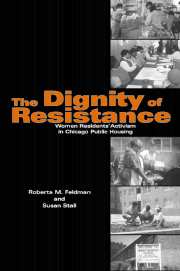Book contents
- Frontmatter
- Contents
- Foreword by Sheila Radford-Hill
- Preface and Acknowledgments
- PART I INTRODUCTION
- PART II WENTWORTH GARDENS' HISTORIC CONTEXT
- PART III EVERYDAY RESISTANCE IN THE EXPANDED PRIVATE SPHERE
- PART IV TRANSGRESSIVE RESISTANCE IN THE PUBLIC SPHERE
- PART V CONCLUSIONS
- Epilogue
- Appendix A Timeline of Wentworth Gardens Resident Activists' Key Initiatives
- Appendix B A Demographic Profile of the Resident Community Activists Interviewed, 1992–1998
- References
- Index
Epilogue
Published online by Cambridge University Press: 06 July 2010
- Frontmatter
- Contents
- Foreword by Sheila Radford-Hill
- Preface and Acknowledgments
- PART I INTRODUCTION
- PART II WENTWORTH GARDENS' HISTORIC CONTEXT
- PART III EVERYDAY RESISTANCE IN THE EXPANDED PRIVATE SPHERE
- PART IV TRANSGRESSIVE RESISTANCE IN THE PUBLIC SPHERE
- PART V CONCLUSIONS
- Epilogue
- Appendix A Timeline of Wentworth Gardens Resident Activists' Key Initiatives
- Appendix B A Demographic Profile of the Resident Community Activists Interviewed, 1992–1998
- References
- Index
Summary
As we conclude our book, a strongly worded editorial in The New York Times entitled, “Facing Up to the Housing Crisis,” argues for federal responsibility to provide decent affordable housing for poor and working-class people. Reporting findings from a bipartisan Congress-appointed Commission, the Millennial Housing Commission, the editorial asserts:
[T]he housing shortage facing the country today is nearly as severe as the one that spurred Congress to act just after World War II [in its passage of the Federal Housing Act of l949]…. In terms of the wealth they created and the communities they stabilized, the federal housing laws were among the most crucial initiatives of the 20th century.
(The New York Times, July 5, 2002, Part A, p. 20)The editorial recognizes that the current Republican administration is unenthusiastic about national support of affordable housing, but that there will be no solution to the housing crisis “unless the federal government gets back into the game”.
Despite the affordable housing crisis nationwide, the number of public housing units continues to fall dramatically, as developments are demolished to make way for new, mixed income housing. The number of affordable housing units also is shrinking in Chicago, while the destruction of CHA public housing units continues B over 24,000 units are ultimately slated for demolition. In Chicago, advocacy groups and organizations focused on affordable housing issues: the Chicago Affordability Coalition, the Chicago Rehab Network, the Chicago Coalition for the Homeless, and in particular, the Coalition to Protect Public Housing, all monitoring the actions of the local, state, and federal housing authorities to protect and increase the number of units and the integrity of affordable housing in Chicago region.
- Type
- Chapter
- Information
- The Dignity of ResistanceWomen Residents' Activism in Chicago Public Housing, pp. 352 - 355Publisher: Cambridge University PressPrint publication year: 2004

